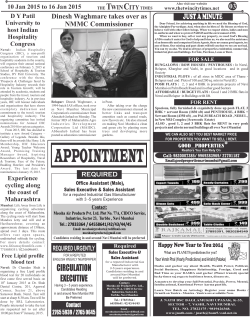
Introduction to and the History of ImmunoHistoChemistry (IHC)
Introduction to and the History of ImmunoHistoChemistry (IHC) Histoteknikerforeningens seminar 20 March 2015 Helle Nielsen, Dako Page 1 IHC – Introduction Immunohistochemistry (IHC) combines histological, immunological and biochemical techniques for the identification of specific tissue components by means of a specific antigen/antibody reaction tagged with a visible label. IHC makes it possible to visualize the distribution and localization of specific cellular components within a cell or tissue. Detection af antigens by antibodies and visualized in a microscope Page 2 IHC – Parameters Page 3 Fixation & tissue preparation Pre-treatment / epitope retrieval Primary antibody Detection system Control material Milestones in IHC Coon Taylor & Huang Shi “Us” Human Genome Label. Ab Protease HIER Experience IgK/L Frozen IgK/L Paraffin B&T cells >100 CD Diagnostic Predictive 1940 1974 2003 2005 Page 4 1991 Spec. Ab Historical overview – detection 1941 IF labeled ab 1967 Enzyme labeled ab Poor sensitivity Page 5 Historical overview – detection 1970 Secondary Un labeled ab 1978 APAAP db staining Page 6 Historical overview – detection 1995 ENVISION™ Polymer Based Detection Dako Avoiding endogenous biotin when high pH HIER is used -can interfere with the interpretation ! Sensitivity increased Page 7 Historical overview – detection 2008 FLEX+ Mouse/rabbit Linker Page 8 Historical overview – detection 1999 Bond™ Polymer Refine Detection (Leica) 2009 UltraView Multimer Detection (Ventana/Roche) Page 9 2012 OptiView Multimer Detection (Ventana/Roche) Historical overview – enzymes IHC - Chromogen Horse Radish Peroxidase (HRP) + high sensitivity + precise chromogenic reaction + can be amplified by metal (Cu/Ni) Alkaline Phosphatase (AP) + suitable for cryostate sections and cytology (hematology) + double IHC staining - granular chromogenic reaction - relative low sensitivity Page 10 Historical overview – chromogens HRP: Diaminobenzidin (DAB) - brown Most commonly used chromogen! Alcohol resistant Amino-Ethyl-Carbazol (AEC) - red Not alcohol resistant NovaRed – red/brown Alcohol resistant AP: Fast Red TR – bright red Not alcohol resistant More Vendors have now Red Chromogens for AP which are alcohol resistant Page 11 Newly released chromogens: HRP: AP: Purple Blue Green Green Black Blue Double/Trippel/Quatro/ .......staining Historical overview – antibodies Quality of antibodies – not optimal in the beginning..... Only polyclonal antibodies, batch to batch variation, unspecific reaction Dr. Niels Harboe realized the need of standardization of the antibodies to make reliable tests for diagnose ! He founded Dako in 1966 together with 110 rabbits!! He began the developement of antibodies to make a immunhistochemstry test reproducible. Page 12 Historical overview – antibodies 1975: Invention of monoclonal antibodies (Kohler & Milstein) Hybridoma technique was born and production of specific antibodies gave a rapid growth in IHC both in research and in diagnosis of cancer. 1991: Heat induced antigen retrieval (Shi et al) Protease 1974 Introduction of HIER (Heat-Induced Epitope Retrieval) IHC could be used in a much broader range of applications in FFPE tissue sections, but a new factor got added to the protocol! Fixation......Preanalytic step.....Standardization?... Page 13 Historical overview ”Immunohistochemistry” articles listed in PubMed in 40 years 35000 30000 25000 20000 15000 10000 5000 0 1973 Page 14 1983 1993 2003 2013 Antibodies Mouse monoclonals - one clone to one antigen determinant High specificity - low to high sensitivity Rabbit polyclonals - more clones to more antigen determinants Low to high specificity - high sensitivity Rabbit monoclonals High specificity – high sensitivity Page 15 Antibodies Monoclonal antibodies Mouse or rabbit hybridoma Tends to be ‘cleaner’ Very consistent batch-to-batch Supernatant / Ascites Polyclonal antibodies Many different species Tends to have more non-specific reactivity Can have very different avidity/affinity batch-to-batch Page 16 IHC – Reaction Pattern IHC staining is widely used in the diagnosis and treatment of cancer IHC is identification of specific antigens (proteins) in cells / tissue using antibodies against the antigen of interest. Antigens (proteins) can be localized in the Cell membrane Cytoplasm Nucleus Page 17 IHC – Reaction Pattern Page 18 IHC – why ? Cases for microscopy (FFPE sections) 70 – 90 % are diagnosed by H&E = standard staining 30 % additional special stains IHC is needed in 10-25% of malignant tumours Narrowing of possibilities Specific diagnosis Unsuspected diagnosis Page 19 IHC – why ? Important to achieve a correct and specific diagnose ! The patient will get the right treatment/therapy ! Diagnose and treatment are linked together. Breast cancer: Ductal Lobular In-situ....... Lung cancer: Small cell NSCLC Adenocarcinoma Planocell. Carcinoma Metastasis ? You often have to use antibodies in a panel! Page 20 IHC – why ? Classification Invasive Therapy Micro organism H&E staining Page 21 IHC – why ? Helps you to find the cells and structures Page 22 IHC – why ? Glioma ? Metastatic carcinoma ? Malignant lymphoma ? Other ? Page 23 IHC – Primary Panel Page 24 Pan-CK S-100 CD45 VIM IHC – Primary Panel Page 25 IHC – why ? Genomic instability in cancer cells Page 26 Mutation Deletion Insertion Translocation Amplification Lack of one or more DNA-repair systems IHC – Mutation Beta Catenin Page 27 IHC – Amplification Guidelines for Scoring HercepTest TM Score:0 HER2 CISH Score: 1+ HER2 FISH Score: 2+ Score: 3+ Chromosome 17 HER2 Over expression of oncoprotein Page 28 IHC – Translocation Anaplastic large cell Lymphoma Follicular Lymphoma Mantle cell Lymphoma MALT Lymphoma, PNET/ES, DSRCT, Page 29 t(2;5) t(14;18) t(11;14) t(1;14), t(11;18) t(11;22) t(11;22) ALK-1 BCL-2 Cyclin-D1 BCL-10 FLI-1 WT-1 IHC – Translocation Over expression of Bcl-2 caused by translocation (t14;18) Immunoglobulin genes (heavy chain or light chain genes) Over expression of Bcl-2 prevent apoptosis Normal lymph node Page 30 Bcl-2 positive follicular lymphoma IHC - Translocation Using IHC instead of ISH present a cost-effective screening for ALK rearrangement in NSCLC Page 31 IHC – Lack of DNA repair gene Page 32 IHC – Lack of DNA repair gene MSH2 Page 33 IHC – Dilution The optimal dilution is a staining giving the maximum signal/noise ratio 100 90 80 70 60 Spec. 50 Unspec. 40 30 20 10 0 FP Signal is the specific signal FN Noise is the unspecific – back-ground signal 1:10. Page 34 1:25. 1:50. 1:100. IHC – Dilution Case 1 Case 2 Pan-CK AE1/AE3 staining in two labs. Serial sections from a multi tissue block with 3 cases of SCLC Page 35 Case 3 IHC- RTU Dakos concept of RTU: RTU is not only an antibody RTU Antibodies RTU is a system of parameters: • antibody • protocol • software • instrument RTU Protocols EnVision Flex Automation “Dako Omnis” “Autostainer” Key opinion leaders • low expressors • high expressors Page 36 IHC- RTU Fra NordiQC run 42 / B18 2014: Antibody name Antibody clone Antibody format Amount of labs % optimal + good results Melan A A103 Conc ab* 100 60 Melan A A103 Dako RTU 43 91 CD15 Carb-3 Conc ab* 55 85 CD15 Carb-3 Dako RTU 49 96 PGR PgR636 Conc ab* 49 90 PGR PgR636 Dako RTU 62 97 *all vendors Page 37 IHC – “old days” In the past IHC was a manual staining process.... Wash, apply, wash, apply..... Every slide was handle separately......time consuming, risk of errors... Page 38 IHC – “old days” Cadenza, Shandon ES, Ventana Page 39 TechMate Dako IHC – Semi-automation LabVision/Thermo Scientific Autostainer Dako 48 link Autostainer Nexes Ventana Biocare IntelliPath Dako Autostainer Plus Page 40 IHC – Pre-treatment Dako PT Link MBO LabVision/ThermoScientific PT module Pressure Cooker Waterbath Page 41 IHC – Total automation Ventana Benchmark Ultra Leica Bond-III BioGenex Xmatrx ULTRA Page 42 Dako Omnis – Total automation IHC/ISH True walk-away solution • 15 minutes of daily set-up time Same day patient case completion • IHC 2:30 hours – run time • ISH 3:40 hours – run time Unmatched throughput • Capability to load up to 165 IHC slides or 60 ISH slides in a typical workday (8 hours/shortest protocols) Including over night run Protocols: • IHC – single/double stain • IF – direct/in direct • ISH – HER2 • Coming: Probes (own and 3rd party) Page 43 Questions Page 44
© Copyright 2025










